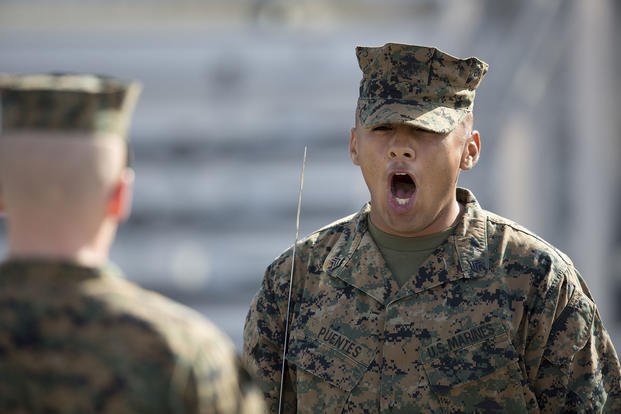A lot of memorization goes on during basic training. Maybe you're the type of person who can easily concentrate while some mean, large person is screaming in your face 24 hours per day, or maybe you're more like me -- you'd rather do your learning in a nice, quiet, relaxing environment. Unfortunately, you're not going to find any nice, quiet, relaxing areas during basic training, so your only other option is to try to memorize this required knowledge before you depart. Part II should be able to help you with your memorization work.
One of the first things you'll be required to know is the military rank/insignia system, especially for the branch you've decided to join. In addition, if you're in the Marines, you will be required to have a basic understanding of the Navy rank structure because the Marine Corps was derived from and falls under the Department of the Navy.
Everyone in the military wears insignia, which are often called stripes for enlisted folks, and you should know what those stripes mean. If you call a sergeant major a private, I can guarantee you won't like the results.
Along those lines, you should commit to memory the proper way to address drill instructors in your particular branch. Just to add to the confusion, each branch does it differently. Don't worry; I give you the straight dope in Part IV.
If you're joining the Army, Navy, Marine Corps or Coast Guard, it's important that you memorize the rules for a sentry. Instructors in these branches like to keep you on your toes by popping out of nowhere, and asking you something like, "What's the third rule of a sentry?" Responding with the correct answer is always preferable to not knowing. If the Air Force is your choice of service, you don't have to worry about this memorization. As an Air Force basic training sentry, you'll carry a book with you at all times during sentry (dorm guard) duty, and you can quickly look up the information, if needed.
Warning: Many new basic training recruits make the mistake of thinking, "I don't need to get in shape in advance. Basic training will get me into shape." Big mistake. By far the biggest reason for getting "set back" in military basic training and not graduating on time is failing to meet the physical fitness graduation standards. You have only a few short weeks in basic to meet very high physical fitness standards for graduation, and -- if you show up out of shape -- you can't do it. You won't fail military basic training for being out of shape (the instructors won't let you), but they'll keep you in basic training as long as it takes for you to pass the standards.
If you have a little extra time, make sure that you look over military law and what constitutes a crime in the military in Appendix A. You don't have to memorize this information, but you should know basic facts, such as if you disobey an order, you can go to military prison for more than five years.
You'll do a lot of marching during military basic training. It certainly wouldn't hurt to practice the basics of marching and the standard drill commands or even join your school's marching band or Junior ROTC program for a little advance practice.
Getting There is Half the Fun
Going to military basic training isn't like leaving home to go to college. You can't just pack whatever you want to bring -- there are rules about what you must have, and more rules about what you can't have.
Traveling to your basic training location usually involves a plane ride, but you can't simply buy a plane ticket and show up. You have to process first through your local Military Entrance Processing Station (MEPS), which will arrange (and pay for) your travel.
Basic training doesn't officially begin until several days after you arrive (although from your point of view, it may seem to begin earlier!). The first few days are spent in-processing -- that is, doing all the paperwork to tell the massive government information system that you're now part of the U.S. military. The term in-processing means more than just giving you a uniform and issuing you a military ID card, though. Part III gives you an idea of what to expect during your first few days of basic.
From Basic Training for Dummies, copyright © 2011 by Wiley Publishing, Inc., Hoboken, New Jersey. Used by arrangement with John Wiley & Sons, Inc.
Interested in Joining the Military?
We can put you in touch with recruiters from the different military branches. Learn about the benefits of serving your country, paying for school, military career paths and more: sign up now and hear from a recruiter near you.











